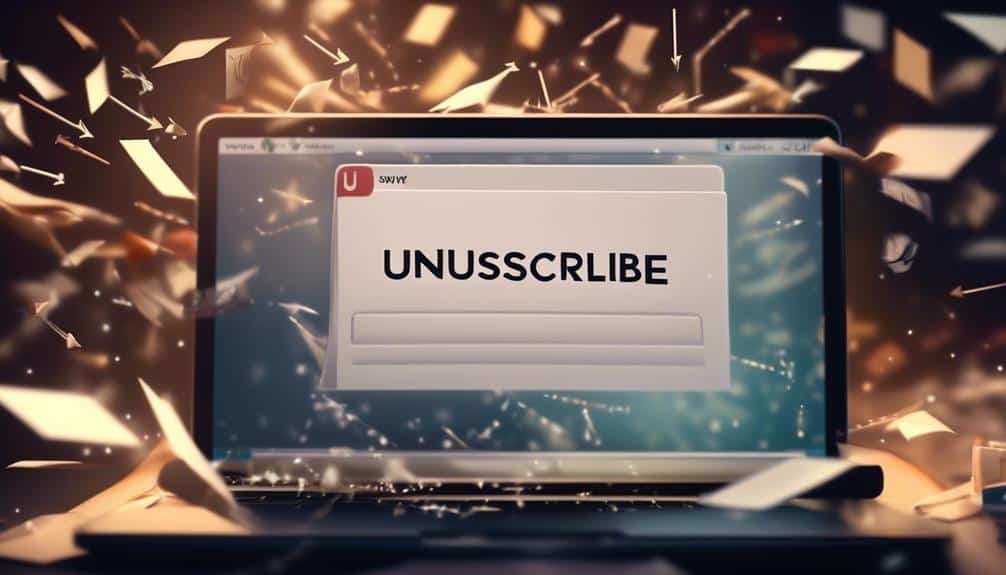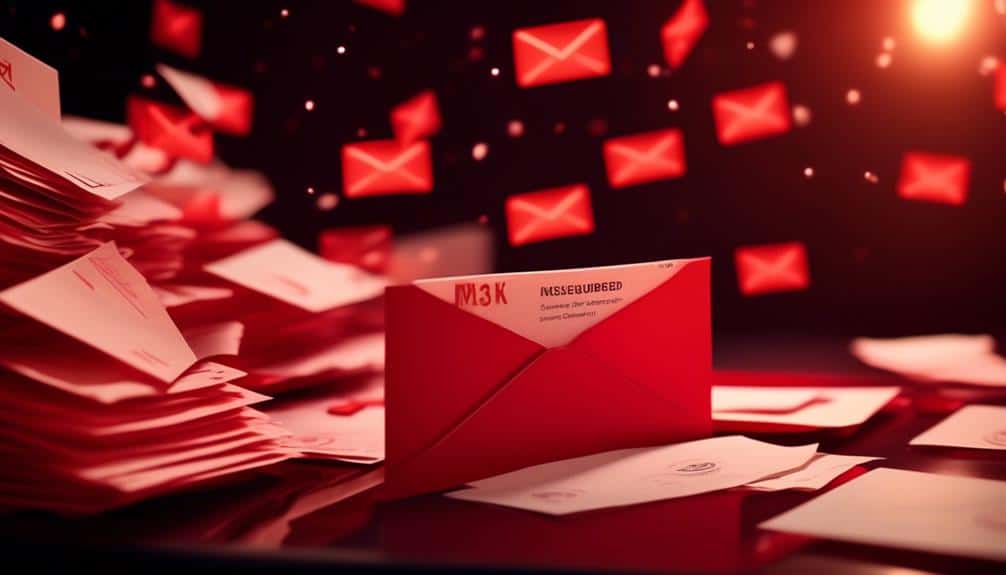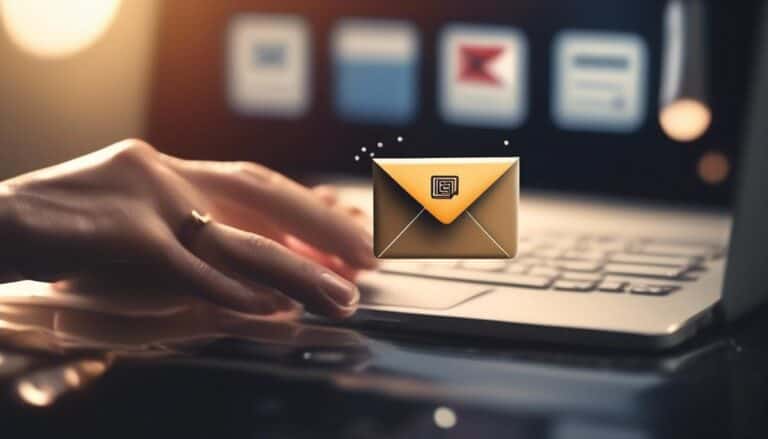Don't Let Unsubscribe Requests Damage Your Email Campaigns: Act Immediately
Did you know that 45% of consumers unsubscribe from email lists because they find the content irrelevant or repetitive? It's a staggering number, and one that should make you pause and consider the impact of neglecting unsubscribe requests.
While it may be tempting to ignore or delay action on these requests, doing so can have a detrimental effect on your email campaigns. In this discussion, we will explore why prompt action is crucial, share best practices for handling unsubscribe requests, and provide strategies for retaining subscribers.
Stay tuned to discover how you can prevent unsubscribe requests from damaging your email campaigns and ultimately, improve your overall email marketing success.
Key Takeaways
- Ignoring unsubscribe requests can have negative consequences such as legal implications, fines, and harm to customer satisfaction.
- Promptly addressing unsubscribe requests shows commitment to open communication, builds customer trust, and maintains a positive brand image.
- Best practices for handling unsubscribe requests include making the process easy, gathering feedback, responding in a timely and professional manner, expressing gratitude, and offering alternative communication channels.
- Streamlining the unsubscribe process by prominently displaying the link, allowing personalization and email frequency options, and sending a confirmation email respects customer preferences.
The Impact of Ignoring Unsubscribe Requests

Ignoring unsubscribe requests can have serious consequences for your business and reputation. It may seem tempting to overlook these requests, especially when you believe they're just a small fraction of your overall email list. However, failing to honor unsubscribe requests can lead to legal implications and severely impact customer satisfaction.
Firstly, let's consider the legal implications. Laws such as the CAN-SPAM Act in the United States require businesses to provide a clear and easy way for recipients to opt-out of future emails. Ignoring unsubscribe requests not only violates these regulations but can also result in hefty fines and damage to your company's reputation. By disregarding the law, you risk losing the trust of your customers and potential legal action.
Secondly, ignoring unsubscribe requests can greatly affect customer satisfaction. When someone requests to unsubscribe, it indicates that they no longer wish to receive your emails. Continuing to send unwanted emails can lead to frustration and annoyance, which will ultimately reflect poorly on your business. Additionally, these dissatisfied customers may spread negative feedback about your company, harming your reputation and potentially deterring others from engaging with your brand.
Understanding the Importance of Prompt Action
To ensure the success of your business and maintain a positive reputation, it's crucial to take prompt action when it comes to unsubscribe requests. Ignoring or delaying these requests can have a detrimental impact on your email campaigns and customer relationships. Here's why prompt action is so important:
- Effective communication: Responding promptly to unsubscribe requests shows that you value your customers' preferences and are committed to open and transparent communication. It allows you to explain any misunderstandings, resolve issues, or offer alternatives that may better suit their needs.
- Building customer trust: By taking immediate action, you demonstrate your respect for your customers' choices and privacy. This builds trust and shows that you prioritize their satisfaction and well-being over your own interests. It also helps prevent negative word-of-mouth and potential damage to your reputation.
- Maintaining a positive brand image: Promptly honoring unsubscribe requests reflects positively on your brand. It shows that you're a responsible and trustworthy organization that respects its customers' decisions. This can enhance your brand's reputation and attract new customers who appreciate your commitment to customer satisfaction.
- Compliance with regulations: Many countries have laws and regulations governing email marketing and unsubscribe requests. By promptly responding to unsubscribe requests, you ensure compliance with these regulations, avoiding potential legal issues and penalties.
Best Practices for Handling Unsubscribe Requests

Implementing effective strategies for handling unsubscribe requests is crucial for maintaining strong customer relationships and maximizing the success of your email campaigns. By responding promptly and professionally to these requests, you can show your commitment to customer satisfaction and build trust with your audience.
First and foremost, it's important to make the unsubscribe process as easy as possible for your customers. Include a clear and prominent unsubscribe link in every email you send, and ensure that the process is simple and hassle-free. This won't only comply with legal requirements, but also demonstrate your respect for your customers' preferences.
When someone unsubscribes, take the opportunity to gather feedback. Include a brief survey or a comment box where they can provide their reasons for unsubscribing. This will help you understand any issues or concerns they may have, and provide an opportunity for you to address them and improve your email campaigns.
Additionally, effective communication is key when handling unsubscribe requests. Respond to these requests in a timely manner and acknowledge the customer's decision. Express your gratitude for their past engagement and assure them that their request will be processed promptly. This will leave a positive impression and show your commitment to excellent customer service.
Lastly, use unsubscribe requests as an opportunity to build customer loyalty. Consider offering alternative communication channels, such as social media or newsletters, to stay connected with those who unsubscribe. By providing valuable content and personalized offers through these channels, you may be able to re-engage customers who initially opted out.
How to Streamline the Unsubscribe Process
Make unsubscribing from your email list a seamless and hassle-free experience for your customers. By streamlining the unsubscribe process, you can't only respect your customers' preferences but also maintain a positive relationship with them.
Here are four ways to make the unsubscribe process easier and more efficient:
- Simplify the unsubscribe link: Ensure that the unsubscribe link is prominently displayed in your emails. Make it easy for customers to find and click on it, without having to search through a long email or navigate through multiple pages.
- Provide options for email personalization: Give customers the ability to customize the content they receive from you. By allowing them to select their preferences, you can ensure that the emails they receive are relevant and valuable to them.
- Allow customers to manage email frequency: Give customers the option to choose how often they receive emails from you. Some customers may prefer weekly updates, while others may only want to receive emails once a month. By providing this flexibility, you can avoid overwhelming your customers with too many emails.
- Confirm the unsubscribe request: After a customer clicks on the unsubscribe link, send them a confirmation email to ensure that they intended to unsubscribe. This step can prevent accidental unsubscribes and give customers an opportunity to reconsider their decision.
Strategies for Retaining Subscribers

Now that you have made unsubscribing a seamless process, it's time to focus on retaining your valuable subscribers and nurturing a long-lasting relationship with them. The key to keeping your subscribers engaged and interested lies in delivering captivating and relevant content. By consistently providing value, you can ensure that they continue to see the benefits of staying subscribed to your emails.
One effective strategy is to create engaging content that speaks directly to your subscribers' interests and needs. Tailor your emails to address their pain points, offer solutions, and provide valuable insights. By doing so, you demonstrate that you understand their challenges and are committed to helping them overcome them.
Another powerful technique is personalization. Use the data you have gathered about your subscribers to segment your email list and send targeted messages. People appreciate messages that feel personalized and relevant to them, rather than generic mass emails. Personalization can go beyond just addressing your subscribers by name; it can include recommending products or services based on their previous purchases or browsing history.
Monitoring and Analyzing Unsubscribe Data
To effectively track and analyze unsubscribe data, it's crucial to gather and analyze relevant metrics that provide insights into subscriber behavior and preferences. By monitoring and analyzing unsubscribe data, you can gain valuable information that can help you improve your email content and increase subscriber engagement.
Here are some important steps to take:
- Segment your unsubscribe data: Categorize the reasons for unsubscribes, such as irrelevant content, too frequent emails, or poor user experience. This will help you identify patterns and make targeted improvements.
- Analyze subscriber engagement: Look at metrics like open rates, click-through rates, and conversion rates to understand how engaged your subscribers are with your emails. Identify segments with low engagement and tailor your content accordingly.
- Conduct surveys: Reach out to unsubscribed subscribers and ask for feedback on why they chose to unsubscribe. This can provide valuable insights into areas for improvement and help you address any issues.
- Test and optimize: Experiment with different email content, subject lines, and send frequencies to see what resonates best with your audience. Continuously monitor and analyze the results to refine your approach.
Frequently Asked Questions
How Can I Prevent Unsubscribe Requests From Negatively Impacting My Email Campaigns?
To prevent unsubscribe requests from hurting your email campaigns, act immediately. Focus on retaining subscribers by improving email engagement. Show your audience that you value their needs and provide valuable content that keeps them interested.
What Are the Potential Consequences of Ignoring Unsubscribe Requests?
Ignoring unsubscribe requests can have potential consequences and negative impacts on your email campaigns. It's crucial to act immediately and address these requests to maintain a positive reputation and retain loyal subscribers.
Can I Delay Taking Action on Unsubscribe Requests?
Delaying action on unsubscribe requests can have serious consequences for your email campaigns. By not promptly removing unsubscribed users, you risk damaging your reputation and losing potential customers. Act immediately to avoid these negative outcomes.
Are There Any Legal Implications if I Don't Promptly Handle Unsubscribe Requests?
Ignoring unsubscribe requests can have serious legal implications. Non-compliance with unsubscribe laws can result in penalties and damage to your reputation. Act promptly to fulfill your legal obligations and avoid the consequences of non-compliance.
What Are Some Common Mistakes to Avoid When Handling Unsubscribe Requests?
When handling unsubscribe requests, it's important to avoid common mistakes that can damage your email campaigns. Follow best practices by promptly honoring requests, making the process simple, and respecting your subscribers' preferences.
Conclusion
Don't let unsubscribe requests be the downfall of your email campaigns. By immediately responding to these requests, you show your subscribers that you value their preferences and privacy.
Implement best practices for handling unsubscribe requests and streamline the process to make it quick and easy for your subscribers.
Additionally, use the data from unsubscribe requests to monitor and analyze trends, allowing you to make informed decisions and strategies to retain your valuable subscribers.
Take action now and keep your email campaigns thriving.








